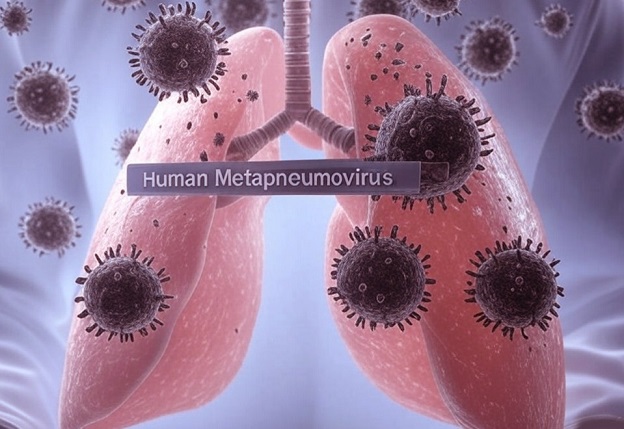Nikhil Prasad Fact checked by:Thailand Medical News Team Jan 13, 2025 3 months, 3 weeks, 6 days, 8 hours, 51 minutes ago
Medical News: Human pneumovirus (HMPV) has gained recognition as a significant contributor to respiratory infections globally, particularly among children, the elderly, and immunocompromised individuals. The complexities of how the human immune system detects and combats this virus have been a central focus of modern virology and immunology research. At the forefront of these investigations are pattern recognition receptors (PRRs), key components of the innate immune system that recognize viral invaders and activate protective responses. Researchers from the University of Texas Medical Branch (UTMB) at Galveston, led by Deepthi Kolli, Thangam Sudha Velayutham, and Antonella Casola, have explored the intricate interplay between PRRs and HMPV in their comprehensive study published in the peer reviewed journal: Pathogens.
 Role of Pattern Recognition Receptors in Human Pneumovirus (HMPV) Infections
Understanding Pattern Recognition Receptors (PRRs)
Role of Pattern Recognition Receptors in Human Pneumovirus (HMPV) Infections
Understanding Pattern Recognition Receptors (PRRs)
PRRs are specialized proteins expressed on immune and non-immune cells, such as epithelial cells, dendritic cells, and macrophages. They act as sentinels, detecting pathogen-associated molecular patterns (PAMPs) found on viruses, bacteria, and other pathogens. The main families of PRRs involved in HMPV detection are Toll-like receptors (TLRs), RIG-I-like receptors (RLRs), and NOD-like receptors (NLRs). Upon recognizing PAMPs, these receptors initiate signaling cascades that result in the production of cytokines, chemokines, and interferons - molecules critical for mounting an antiviral response.
This
Medical News report sheds light on how these PRRs interact with HMPV to modulate immune responses and shape disease outcomes, providing a foundation for developing targeted treatments and vaccines.
HMPV: A Global Respiratory Threat
First identified in 2001, HMPV is now recognized as a leading cause of respiratory infections worldwide. Retrospective studies suggest its presence as early as the 1950s. HMPV primarily affects children, with nearly all individuals exposed to the virus by the age of five. In severe cases, HMPV can cause bronchiolitis and pneumonia, particularly in vulnerable populations such as premature infants and those with chronic conditions.
HMPV is a member of the Pneumovirinae subfamily within the Paramyxoviridae family, which includes other respiratory pathogens like respiratory syncytial virus (RSV). While HMPV and RSV share similarities, they induce distinct immune responses, underscoring the need for tailored therapeutic approaches.
Toll-Like Receptors: The First Line of Defense
Among PRRs, TLRs are the most studied in the context of HMPV. These receptors detect viral components such as RNA and proteins, triggering the activation of nuclear factor kappa B (NF-κB) and interferon regulatory factors (IRFs). Key TLRs implicated in HMPV infections include TLR3, TLR4, and TLR7/8:
-TLR3: Recognizes double-stranded RNA, a replication intermediate of HMPV. Studies have shown that TLR3
activation leads to the production of chemokines such as CXCL10 and CCL5, which recruit immune cells to infection sites. TLR3-deficient models exhibited heightened inflammation and mucus production, highlighting its role in balancing immune responses.
-TLR4: Interacts with the HMPV fusion protein to initiate signaling pathways. Interestingly, TLR4’s involvement in HMPV-induced inflammation has dual effects: while it promotes antiviral defenses, it can also contribute to tissue damage and airway hyperresponsiveness.
-TLR7/8: Detect single-stranded RNA and are primarily expressed in immune cells like dendritic cells and macrophages. Their activation by HMPV drives the production of type I interferons, pivotal in establishing an antiviral state.
RIG-I-Like Receptors: Intracellular Viral Sensors
RLRs, including RIG-I and MDA5, play a central role in detecting viral RNA within infected cells. RIG-I recognizes the 5’ triphosphate end of HMPV RNA, triggering mitochondrial antiviral signaling protein (MAVS)-dependent pathways. This leads to the activation of NF-κB and IRF3, resulting in the production of interferons and inflammatory cytokines. The UTMB study revealed that RIG-I, more than MDA5, is critical for controlling HMPV replication and preventing excessive inflammation.
NOD-Like Receptors: Mediators of Inflammation
NLRs, particularly the NLRP3 inflammasome, are emerging as important players in HMPV infections. The inflammasome is a multiprotein complex that activates caspase-1, leading to the maturation and release of interleukin-1β (IL-1β) and IL-18. These cytokines amplify inflammatory responses, contributing to both viral clearance and lung pathology. Research indicates that the activation of the NLRP3 inflammasome by HMPV is influenced by mitochondrial dysfunction and reactive oxygen species.
Key Findings from the UTMB Study
The researchers at UTMB utilized both in vitro and in vivo models to dissect the roles of various PRRs in HMPV infections. Their findings include:
-TLR3 and TLR4’s Dual Roles: While these receptors are essential for initiating antiviral responses, their overactivation can exacerbate lung inflammation and airway obstruction.
-RIG-I’s Dominance: RIG-I was identified as the primary receptor for HMPV RNA, with its activation crucial for interferon production and viral control. MDA5 played a secondary role.
-NLRP3 Inflammasome Activation: The inflammasome’s involvement in IL-1β production underscores its contribution to the inflammatory milieu observed in severe HMPV cases.
-Interplay Between PRRs: The study highlighted how TLRs, RLRs, and NLRs work synergistically to detect and respond to HMPV, with each pathway contributing unique aspects to the immune response.
Implications for Therapeutics and Vaccines
Understanding the roles of PRRs in HMPV infections offers pathways for developing targeted interventions. Potential strategies include:
-TLR Modulation: Designing therapeutics that enhance beneficial TLR signaling while minimizing inflammation.
-RIG-I Agonists: Developing small molecules that mimic HMPV RNA to boost antiviral defenses.
-Inflammasome Inhibitors: Targeting the NLRP3 inflammasome to reduce lung damage without compromising viral clearance.
Conclusion
The intricate interplay between HMPV and the host immune system underscores the complexity of designing effective treatments. PRRs such as TLRs, RLRs, and NLRs play pivotal roles in recognizing the virus and orchestrating immune responses. However, their dual roles in protection and pathology present challenges that demand nuanced therapeutic approaches. The UTMB study advances our understanding of these mechanisms, paving the way for innovations in managing HMPV infections.
The study findings can be found here:
https://www.mdpi.com/2076-0817/2/2/232
For the latest HMPV News, keep on logging to Thailand
Medical News.
Read Also:
https://www.thailandmedical.news/news/human-metapneumovirus-hmpv-exhibits-ocular-tropism-and-can-infect-the-eyes
https://www.thailandmedical.news/news/the-antiviral-potential-of-hra2pl-fusion-peptide-derived-from-the-tobacco-plant-against-human-pneumovirus-hmpv
https://www.thailandmedical.news/news/israeli-study-finds-that-immunity-gene-ceacam1-shows-potential-against-respiratory-viruses-including-hmpv
https://www.thailandmedical.news/articles/hmpv-human-metapneumovirus
